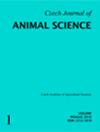与先前发情同步的茨瓦布尔羊宫颈粘液结晶结构的评价
IF 1.3
4区 农林科学
Q3 AGRICULTURE, DAIRY & ANIMAL SCIENCE
引用次数: 0
摘要
本研究进行了toÂ确定个体类型ofÂ结晶结构ofÂ宫颈粘液(树突现象)inÂ羊,并在发情期改变inÂ类型ofÂ这些结构。AÂ总共of 80只2至8岁的母羊被纳入inÂ研究。使用阴道内海绵进行发情同步,并在取出ofÂ阴道内海绵55-57 h后收集样本ofÂ宫颈粘液并随后进行评估。结晶结构ofÂ宫颈粘液ofÂ羊在发情期表现出相同的顺序asÂ在牛。最常见的ofÂ结晶inÂ类型为细枝状(33.33%)、细枝状棒状苔藓(24.00%)和棒状苔藓(14.67%)。最不常见的是蕨类植物叶结晶(1.33%)。AÂ不同个体类型之间的表现有统计学差异of ofÂ结晶(P < 0.01)。AsÂ对于牛,可以toÂ使用评估ofÂ结晶ofÂ宫颈粘液toÂ确定最佳授精时间,特别是inÂ组ofÂ以前同步/诱导发情的动物ofÂ。确定与aÂ公羊进行授精或自然交配的正确时间,可以toÂ优化育种管理并提高怀孕率,这对于inÂ繁殖这些季节性多情动物至关重要。根据结果,可以认为,在取出ofÂ阴道内海绵并应用ofÂ诱导和同步发情的激素治疗(马绒毛膜促性腺激素)后57+ h应进行人工授精。本文章由计算机程序翻译,如有差异,请以英文原文为准。
Evaluation of crystallisation structures of cervical mucus in Zwartbles sheep with previous oestrus synchronisation
This study was conducted to determine the individual types of crystallisation structures of cervical mucus (arborisation phenomenon) in sheep and changes in the types of these structures during oestrus. A total of 80 ewes aged between two and eight years were included in the study. Oestrus synchronisation was performed using intravaginal sponges, and samples of cervical mucus were collected 55–57 h after the removal of intravaginal sponges and subsequently evaluated. The crystallisation structures of the cervical mucus of sheep exhibit the same sequence during oestrus as in cattle. The most frequently occurring types of crystallisation in the observed sheep included twig-shaped (33.33%), twig-shaped-clubmosses (24.00%) and clubmosses (14.67%). The least common type was fern frond crystallisation (1.33%). A statistically significant difference was found between the representation of individual types of crystallisation (P < 0.01). As with cattle, it is possible to use the evaluation of the crystallisation of cervical mucus to determine the optimum time for insemination, especially in groups of animals with previous synchronisation/induction of oestrus. Establishing the correct time for insemination or natural mating with a ram makes it possible to optimise breeding management and improve pregnancy rates, which are crucial in breeding these seasonally polyoestrous animals. Based on the results, it can be stated that insemination should take place 57+ h after the removal of intravaginal sponges and the application of hormonal treatments for oestrus induction and synchronisation (equine chorionic gonadotropin).
求助全文
通过发布文献求助,成功后即可免费获取论文全文。
去求助
来源期刊

Czech Journal of Animal Science
Agriculture, Dairy & Animal Science-奶制品与动物科学
CiteScore
2.40
自引率
16.70%
发文量
44
审稿时长
5 months
期刊介绍:
Original scientific papers and critical reviews covering all areas of genetics and breeding, physiology, reproduction, nutrition and feeds, technology, ethology and economics of cattle, pig, sheep, goat, poultry, fish and other farm animal management. Papers are published in English.
 求助内容:
求助内容: 应助结果提醒方式:
应助结果提醒方式:


